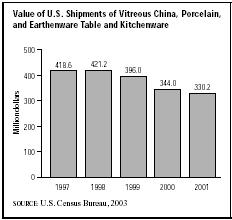SIC 3262
VITREOUS CHINA TABLE AND KITCHEN ARTICLES
This industry consists of companies that manufacture vitreous china table and kitchen articles, such as bone china, vitreous china tableware, vitreous china dishes, and china cooking ware. Manufacturers of fine earthenware table and kitchen articles are In SIC 3263: Fine Earthenware (Whiteware) Table and Kitchen Articles.
NAICS Code(s)
327112 (Vitreous China, Fine Earthenware and Other Pottery Product Manufacturing)
Manufacture of vitreous china table and kitchen articles is an anomaly in twentieth- and early twenty-first-century America. It is a very labor-intensive industry, with skilled craftsmen perfecting work that has extremely high standards of quality. In this industry, much of the technology is the same as it was ages ago. Many glaze recipes, clays, molds, casting, and firing processes have remained unchanged, but potters' wheels are electric, and jiggerblades quickly shape the pieces.
Porcelain was being made in China as early as the ninth century. Many centuries later, the Ohio River valley became the first china-manufacturing center in the United States. Here manufacturers had easy access to kaolin, the soft, white clay that is essential to the manufacture of china and porcelain.
Vitreous china is made of clays that are glazed and fired at extremely high temperatures. The temperatures cause the glaze to fuse with the clay and become nonporous. This china is both delicate and extremely durable. For this reason, it is used in hotels and restaurants more often than the semivitreous earthenware manufactured in SIC 3263.
The industry is closely tied to economic conditions because many people consider china to be a luxury. Also, since the manufacturers sell to the hotel and restaurant trade, they suffer when there is a slump in new hotel and restaurant openings. The bridal market accounts for a large percentage of sales of bone china and other vitreous china table articles, and when this market suffers, so does the industry. Competition from abroad is intense. Imports account for about half of the U.S. market of housewares, kitchenware, and tableware. Some U.S. manufacturers have part of the work done overseas and finish their pieces in this country.
As consumer confidence waned amidst the U.S. economic downturn that began in 2000, the industry declined. The value of industry shipments, which had dipped from $1.48 billion in 1997 to $1.44 billion in 1999, declined further to $1.15 billion in 2001. The table and kitchenware segment of this industry, which accounts for nearly 30 percent of total industry sales, saw the value of shipments decline from $418.6 million in 1997 to $330.2 million in 2001.
Most industry leaders have been in the business for many years. Pfaltzgraff, founded in 1811 and headquartered in York, Pennsylvania, is said to be the oldest continuously operating pottery in the country. It is owned by the privately held company Susquehanna Broadcasting. Pfaltzgraff purchased another well-known chinaware manufacturer, Syracuse, in 1983. Lenox China, founded

in 1889 in Trenton, New Jersey, was bought by Brown-Forman in 1983. Oneida, which bought Buffalo China in 1983, was founded in 1848 and was originally known for its quality flatware. Homer Laughlin was founded in 1871 in West Virginia.
The three top companies in 2003 were Corning Inc., of Corning, New York, with nearly three billion dollars in sales; Lenox Inc., of Lawrenceville, New Jersey, with sales of $370 million; and Mikasa, Inc., of Secaucus, New Jersey, a subsidiary of France-based ARC International.
Industry jobs include machine operators in the slip-house; mold runners, casters, and jiggermen who shape and form the clay; cutters and finishers who dry and secondary shape; glaze grinders and decorators; kiln firemen and loaders; inspectors, selectors, and stampers; and packers. Average hourly wages for production workers in this industry were $11.20 in the early 2000s. Kiln operators earned hourly wages of $6.06 to $9.26, while molders and casters earned $4.61 to $9.86 per hour.
According to the U.S. Census Bureau, 18,696 people were employed in this industry in 2000, compared to 23,253 in 1997. Production workers in 2000 totaled 15,315. The cost of materials used by the industry was $508.8 million dollars in 2000, a decline from $540.9 million in 1997. An estimated 1,000 establishments produce vitreous china, as well as fine earthenware, discussed in SIC 3263: Fine Earthenware (Whiteware) Table and Kitchen Articles .
The U.S. industry endures heavy worldwide competition, especially with Japan, Taiwan, China, and England. However, a weaker dollar has meant that exports from the United States have increased, especially to Taiwan, Canada, and Mexico, while foreign products have become more expensive, making domestic products more attractive at home.
Some manufacturers were looking in new technological directions to beat foreign competitors, such as Pfaltzgraff, the first in the industry to have a dry press system, which formed, finished, decorated, glazed, and fired china in one continuous process. It vastly increased productivity. The company also invested in a CAD/CAM system that provided 3-D images of finished china products.
Further Reading
U.S. Census Bureau. "Statistics for Industry Groups and Industries: 2000." February 2002. Available from http://www.census.gov/prod/2002pubs/m00as-1.pdf .
——. "Value of Shipment for Product Classes: 2001 and Earlier Years." December 2002. Available from http://www.census.gov/prod/2003pubs/m01as-2.pdf .
Comment about this article, ask questions, or add new information about this topic: